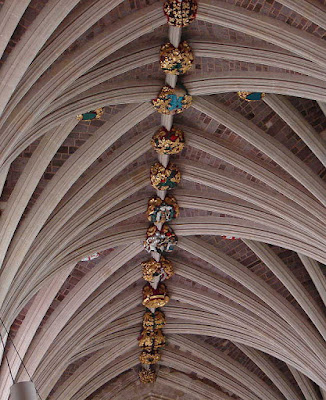
Exeter Cathedral is considered the finest surviving example of Decorated Gothic, a form of architecture that flourished in England from 1270 to 1369. The Cathedrals of England calls it "the Decorated cathedral par excellence." Frommer's England agrees, adding that Exeter Cathedral is simply "one of the prettiest churches anywhere."


Inside Exeter Cathedral, the Late Decorated Gothic nave (1328-1369) makes quite an impact, especially the graceful tierceron vaulting of the ceiling. It is the longest unbroken Gothic ceiling in the world, which stands at a height of 20m (66 ft) and stretches for 90m (300 ft).

The ceiling also features oversized, richly painted bosses - one near the west end depicts the murder of Thomas a Becket. The overall effect has been compared to an avenue of stately trees.


The largest of the bosses weighs over two tons.

This is the ceiling in the Lady Chapel.

This is the West window. On the floor of the nave are various gravestones and I shall do a separate posting about them. I shall also do a separate post about military and other memorials.


High on the left side of the nave is the Minstrels' Gallery (c.1350), with painted sculptures of angels playing various musical instruments. These have been repainted and regilded after their original design.


The pulpit at the northeast corner of the nave was designed by Sir George Gilbert Scott. It depicts the martyrdom of St Alban and St Boniface and a Victorian missionary Bishop.

The organ at the Transept crossing.

More organ pipes.
South aisle, East end.



On the North wall of the North transept is a large, blue-faced astronomical clock, donated by Bishop Peter Courtenay (1478-87). The minute hand was added in 1759. A fleur-de-lys represents the sun cycles around a 24-hour dial, with noon at the top and midnight at the bottom. The moon's phases are shown and the day of the lunar month can be read from the inner ring. The gold ball in the centre represents the earth.


In the choir there is a full set of misericords dating from 1260. This elephant one may have been carved from a pciture of an elephant given to Henry III. Unfortunately most of the misericords are kept roped off.




The woodwork in the choir is simply superb.

The Chapel of St James and St Thomas, off the south choir aisle, was completely destroyed by a German bomb on May 4, 1942 but has since been reconstructed and is now associated with the Devon and Dorset Regiment.



This is an unusual 16th century cadaver tomb. A cadaver tomb is a monument where an effigy of the deceased is shown, often resting underneath an effigy of the person as in life. The cadaver was represented as an emaciated corpse, almost skeletal, either shrouded or partially or totally exposed from its shroud. The cadaver was a depiction of the inevitibility of death, no matter how great a person's earthly status. The inscription above the tomb reads Ista figura docet nos omnes premeditari Qualiter ipsa nocet mors quando benit dominari. I think this translates as "This figure instructs us all to think of nature herself as bad death when she is a kindly lady." On the other hand, maybe it doesn't say that!!!

Since I shall get told off if I end on a morbid note I shall show this self-portrait of me taking a coffee break in the refectory.... I hope that is not equally macabre.
4 comments:
Thanks for posting this! I've been to Exeter cathedral two year ago but I have too little time to see all its treasures.
Who was the person buried under that spectacular cadaver memorial?
Sorry Memmori, I regret I don't have a note of who was buried under that cadaver. It was obviously someone very rich to have a stonemason do such work on their tomb.
In regards to the cadaver tomb translation, I translate it roughly as: "This figure teaches all of us to think in what way death herself damages us when she appears to judge/stand judgment upon us."
Seems apropos.
Thanks for that, jf...
Post a Comment